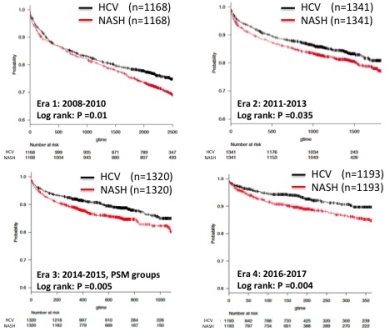Hidden Risk of Liver Transplantation for Nonalcoholic Steatohepatitis: A Propensity Score Matched Study
S. Nagai,1 R. Schilke,1 M. Safwan,1 M. Rizzari,1 K. Collins,1 A. Yoshida,1 M. Abouljoud,1 D. Moonka.2
1Transplant and Hepatobiliary Surgery, Henry Ford Hospital, Detroit, MI
2Gastroenterology, Henry Ford Hospital, Detroit, MI.
Meeting: 2018 American Transplant Congress
Abstract number: 68
Keywords: Hepatitis C, Liver cirrhosis, Metabolic disease, Obesity
Session Information
Session Name: Concurrent Session: Liver: Recipient Selection
Session Type: Concurrent Session
Date: Sunday, June 3, 2018
Session Time: 2:30pm-4:00pm
 Presentation Time: 2:30pm-2:42pm
Presentation Time: 2:30pm-2:42pm
Location: Room 6C
Aim: There is a recent shift in the number of liver transplants (LT) performed in patients with hepatitis C (HCV) to those with non-alcoholic steatohepatitis (NASH). LT recipients with NASH are at risk for medical comorbidities associated with worse outcomes after LT including older age, obesity, and diabetes. We compare transplant outcomes between patients with HCV and NASH using propensity score-matching (PSM).
Methods: Retrospective data of LT recipients (≥18yo) from the UNOS registry (2008 to 2017) were analyzed. Era of LT was divided into four groups (Era 1: 2008-2010, Era 2: 2011-2013, Era 3: 2014-2015, Era 4: 2016-2017). Clinically significant donor and recipient characteristics were balanced by PSM between the HCV and NASH groups in each Era, except for recipient age, body mass index, and history of diabetes (NASH associated characteristics). The hazard of graft failure between the HCV and NASH groups were compared using multivariable Cox regression models.
Results: A total of 18,970 patients with HCV and 5,899 patients with NASH underwent LT. Patients with NASH had significantly older recipient age (59.4 vs. 57.2 years, P<0.001), higher BMI (28.3 vs. 27.6, P<0.001), and higher prevalence of diabetes (58.8% vs. 23.9%, P<0.001). Age in the NASH group continued to increase and the trend was significant (58.8, 59.1, 59.5, and 60.2 years in Eras 1, 2, 3 and 4, respectively, P<0.001). PSM confirmed balance of characteristics, except for the NASH associated characteristics. The NASH group showed worse graft survival in all four Eras.  PSM hazards of graft failure among NASH patients in Eras 1, 2, 3, and 4 were 1.235, 1.23, 1.35, and 1.479 times those with HCV (P=0.009, 0.025, 0.006, and 0.009, respectively).
PSM hazards of graft failure among NASH patients in Eras 1, 2, 3, and 4 were 1.235, 1.23, 1.35, and 1.479 times those with HCV (P=0.009, 0.025, 0.006, and 0.009, respectively).
Conclusions: The PSM risk of graft failure was significantly higher in NASH patients than in those with HCV throughout the study period. The risk of LT for NASH may be underestimated. These results suggest important implications for risk stratification in an era of shifting indications for LT.
CITATION INFORMATION: Nagai S., Schilke R., Safwan M., Rizzari M., Collins K., Yoshida A., Abouljoud M., Moonka D. Hidden Risk of Liver Transplantation for Nonalcoholic Steatohepatitis: A Propensity Score Matched Study Am J Transplant. 2017;17 (suppl 3).
To cite this abstract in AMA style:
Nagai S, Schilke R, Safwan M, Rizzari M, Collins K, Yoshida A, Abouljoud M, Moonka D. Hidden Risk of Liver Transplantation for Nonalcoholic Steatohepatitis: A Propensity Score Matched Study [abstract]. https://atcmeetingabstracts.com/abstract/hidden-risk-of-liver-transplantation-for-nonalcoholic-steatohepatitis-a-propensity-score-matched-study/. Accessed December 16, 2025.« Back to 2018 American Transplant Congress
